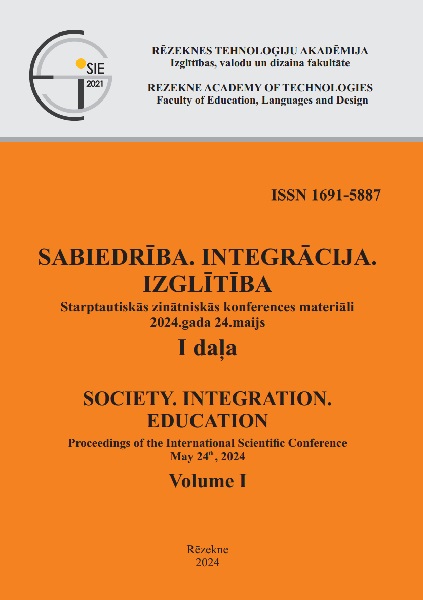VISUALIZING EDUCATIONAL INFORMATION: PRIMARY SCHOOL TEACHERS’ VIEWS
DOI:
https://doi.org/10.17770/sie2024vol1.7885Keywords:
primary school, primary school teachers, teachers’ visualizing skills, visual literacy, visualizing educational informationAbstract
The study’s major purpose was to compare primary school teachers’ views on visualizing educational information under conditions of the reform of Ukrainian education being in progress and unforeseen global impacts (martial law in Ukraine and the Covid-19 pandemic). The survey was conducted within the time period of 2019 spring – 2022/2023 winter. The total number of respondents consisted of 265 primary school teachers.
Gradual primary school teachers’ reorientations regarding the essence of visualizing educational information were determined as a strong positive tendency: from the position of its identification associated with the didactic field of the use of visual means to the consideration of visualizing educational information as an effective didactic tool boosting the use of interactive methods of teaching and learning in primary school.
A significant rethinking of the didactic potential of using visualization in the educational process of primary school was being observed. The implementation speed of forms, methods and means of information visualization in the educational process of primary school changed positively as a result of experimental didactic influences. But the dynamics of changes was not correspondingly enough to the needs of modern educational requirements. Concluded the inappropriate development of primary school teachers’ visualizing educational information skills that are to be intensively improved among primary school teachers.
References
Alessandrini, G., & Rosso, G. (2009). University training on communities of practice. In Encyclopedia of information communication technology (791–794). IGI Global. DOI: https://doi.org/10.4018/978-1-59904-845-1.ch104
Kędra, J., & Žakevičiūtė, R. (2019). Visual literacy practices in higher education: what, why and how? Journal of visual literacy, 38(1-2), 1–7. DOI: https://doi.org/10.1080/1051144x.2019.1580438
Knoop‐van Campen, C. A. N., van der Graaf, J., Horvers, A., Kooi, R., Dijkstra, R., & Molenaar, I. (2024). Enacting control with student dashboards: The role of motivation. Journal of computer assisted learning. DOI: https://doi.org/10.1111/jcal.12936
Kunjir, A. R., & Patil, K. R. (2020). Challenges of mobile augmented reality in museums and art galleries for visitors suffering from vision, speech, and learning disabilities. In Virtual and augmented reality in education, art, and museums (162–173). IGI Global. DOI: https://doi.org/10.4018/978-1-7998-1796-3.ch009
Malykhin, O., Kaupuzs, A., Aristova, N., Orska, R., & Kalvans, E. (2023). Anxiety among school-age children in war-affected areas in Ukraine and ways to reduce it: Parents’ views. Society. Integration. Education. Proceedings of the international scientific conference, 1, 553–563. DOI: https://doi.org/10.17770/sie2023vol1.7088
Mіnіsterstvo osvіti і nauki Ukraїni, EdEra & Osvіtorіja. (n. d.). Onlajn-kurs dlja vchitelіv pochatkovoї shkoli.. Retrieved from https://courses.ed-era.com/courses/course-v1:MON-EDERA-OSVITORIA+ST101+st101/about
Nissen, M. E. (2020). Reconsidering a system for measuring dynamic knowledge: extending a novel line of research. In Current issues and trends in knowledge management, discovery, and transfer (48–70). IGI Global. DOI: https://doi.org/10.4018/978-1-7998-2189-2.ch003
Özsoy, V., & Saribaş, S. (2021). Developing visual literacy skills in teacher education: different ways of looking at the visual images. Educational policy analysis and strategic research, 16(3), 67–88. DOI: https://doi.org/10.29329/epasr.2021.373.5
Ponners, P. J., & Piller, Y. (2020). The reality of augmented reality in the classroom. In Cognitive and affective perspectives on immersive technology in education (51–66). IGI Global. DOI: https://doi.org/10.4018/978-1-7998-3250-8.ch003
Salunkhe, V., Kaithathara, S. T., Darshan, S. M., Gowri, S. R., & Shabarisha, N. (2022). A paradigm shift in higher education: evidence-based cross-sectional study conducted in South India. In Handbook of research on acquiring 21st century literacy skills through game-based learning (107–121). IGI Global. DOI: https://doi.org/10.4018/978-1-7998-7271-9.ch006
Schoenherr, J., & Schukajlow, S. (2023). Characterizing external visualization in mathematics education research: a scoping review. ZDM – Mathematics Education. DOI: https://doi.org/10.1007/s11858-023-01494-3
Supli, A. A., & Yan, X. (2023). Exploring the effectiveness of augmented reality in enhancing spatial reasoning skills: A study on mental rotation, spatial orientation, and spatial visualization in primary school students. Education and information technologies. DOI: https://doi.org/10.1007/s10639-023-12255-w
Topuzov, O., Malykhin, O., & Aristova, N. (2022). General secondary teachers’ views on educational process amid the covid-19 pandemic: two-year experience of blended learning. Society. Integration. Education. Proceedings of the international scientific conference, 1, 549–559. DOI: https://doi.org/10.17770/sie2022vol1.6841
Tufte, E. R. (2001). The visual display of quantitative information (2nd ed.). Graphics Press.
Ursyn, A. (2015). Cognitive learning with electronic media and social networking. In Handbook of research on maximizing cognitive learning through knowledge visualization (pp. 1–71). IGI Global. DOI: https://doi.org/10.4018/978-1-4666-8142-2.ch001
Wen, X., & Wang, X. (2020). Data visualization in online educational research. In Advancing educational research with emerging technology (248–273). IGI Global. DOI: https://doi.org/10.4018/978-1-7998-1173-2.ch012
Zheng, R. (2008). Cognitive functionality of multimedia in problem solving. In Handbook of research on instructional systems and technology (232–248). IGI Global. DOI: https://doi.org/10.4018/978-1-59904-865-9.ch017
Zimmermann, W., & Cunningham, S. (1991). Visualization in teaching and learning Mathematics. Mathematical association of America.






